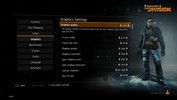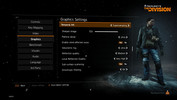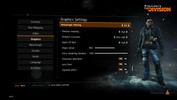The Division Notebook Benchmarks
For the original German article, see here.
Graphics
Ubisoft's release of Tom Clancy's The Division is an ambitious undertaking, which successfully combines aspects from various game genres. While the gunfights remind us of cover-based shooter games like Gears of War, behind the scenes there's a distinct RPG influence as well, which makes this game a rather unique experience. The gloomy scene with the destroyed houses feels rather fresh and not at all over-used.
From a graphics perspectives, the PC version delights across the board. The biggest highlight is - in our opinion - the sheer number of incorporated details. Outdoors as well as inside, the respective surroundings are bursting with decorative elements, be it debris or home furnishings. Other titles almost seem generic and bland in comparison. The lighting, the shadows, and the details of the characters are great as well. An extensive wide-angle view, which augments the atmosphere, rounds out the package. The game generally lacks undefined textures and cheap effects, although the flames could look a little better (see Far Cry Primal, for example).
Another plus is the inherent flexibility. The PC game spoils its users with an extensive graphics menu, which includes several presets and dozens of individual options including explanations.
Ubisoft uses a no-holds-barred approach and applies a variety of modern techniques like parallax mapping, ambient occlusion, contact shadows, sub-surface scattering, and volumetric fog. The creators also make use of temporal anti-aliasing and FXAA, respectively SMAA post-processing.
Users who love to tinker with the settings will be happy to know that most changes don't require a restart of the game. As a matter of fact: to enjoy the game in its full glory, tweaking is almost a necessity. Even the ultra preset doesn't automatically set all sliders to their maximum. Some of the effects (for example the shadow option HFTS) are restricted to Nvidia GPUs or at least optimized for them.
The ultra setting is visually very impressive, although the differences between it and the high preset aren't that extensive. Medium settings do lower the graphic quality a little, minimum details have a more severe impact. The result is never ugly, however.
The version available right now is pretty solid overall. Since this is a huge and very complex game, we wouldn't have been surprised at all had there been more problems. Still, we encountered some issues during our review, which we think Ubisoft needs to address:
- When changing the resolution, The Devision sometimes crashes or is prone to errors (wrong scaling, graphics bugs). 4K only ran only flawlessly on our desktop.
- Switching between menus and starting the game can sometimes result in a black display, which at times can be corrected by pressing Alt + Tab or activating window-mode (Alt + Enter). The same is actually true for point 1 as well.
- At this time, connection drops happen, which is particularly annoying since the game requires a permanent online connection. The game then either returns the user to the main menu or dumps him/her on the desktop.
- Quite a few of the menus aren't exactly intuitive and seem to be designed for gamepads. The standard key assignment is also not ideal ("vault" requires the use of the Ctrl key instead of the space bar).
- The load times don't seem to depend on the type of hard drive and fluctuate wildly. Depending on the system, it can take a few seconds or several minutes.
- On notebooks equipped with graphics switching, we sometimes encountered warning messages telling us that the system didn't meet the requirements - but the game still ran without a hitch.
- It sometimes seems to take forever before any setting changes are applied. The game appears to be frozen when that happens.
- Depending on the situation, the frame rate can fluctuate severely. Inside, the performance is frequently much better than outside. This makes it hard to recommend a GPU.
- On rare occasions, we encountered issues at the lowest settings when using an Intel Iris 6100 GPU with the current driver.
Some of the bugs above can possibly be attributed to the graphics driver. For our Nvidia systems we used ForceWare 364.47 - a driver which Nvidia withdrew shortly thereafter because of some other issues and replaced it with ForceWare 364.51
Benchmark
Thanks to the integrated benchmark, users can gauge the performance of the currently applied settings. The sequence lasts 1.5 minutes and consists of a camera sweep through several streets. Even though the frame rate doesn't correspond exactly to the real action (the game is slightly more demanding), we decided to use this sequence. First of all, we intend to use The Devision as a base for our notebook tests, so comparability and ease of use take precedence over bona fide results. Secondly, it's impossible to turn off the day/night cycle, which in turn would influence the results negatively.
The integrated benchmark isn't perfect. When we cross-checked the fps indicated on the left with the tool Fraps, we noticed that the average values indicated at the end were often much too high - subjectively, we also knew that something was amiss. This is probably a bug. Since the minimum fps are not displayed either, we decided to ignore the benchmark results and to use Fraps instead. Since the performance fluctuates greatly, the hardware needs to be up to par for the demanding scenes. Between 35-40 fps, the game likely will run stutter-free.
Results
Not surprisingly, the third-person game requires a lot of GPU power. The Division doesn't run smoothly on entry-level graphics card like the HD Graphics 4600 or GeForce GT 740M at all - no matter at what settings. For a resolution of 1280 x 720 pixels and the low preset, the system in question needs to be equipped with a mid-range graphics card. Even the GeForce GT 750M and the 940M(X) have some problems here (~30 fps). 1366 x 768 pixel and medium details require at least a GeForce GTX 850M or GTX 950M.
A resolution of 1920 x 1080 require a true gaming laptop. The medium preset requires a GeForce GTX 960M or GTX 870M, the high preset needs the 2016-edition of the GTX 965M. We recommend a GeForce GTX 980M for the highest settings. For notebooks, 3840 x 2160 pixels are more or less out of the question. Even a desktop-specific GTX 980 failed to produce acceptable results at 4K with the details set to high.
The conclusion after considering all benchmark results: the demands on the hardware are unquestionably high. The overall quality is very good though, which in turn lessens the hardware requirements somewhat. The processor plays a secondary role at best - even on the Intel platforms, the bottleneck remained the GPU (we will add AMD benchmark results at a later time).
| The Division | |
| 3840x2160 High Preset AF:8x 1920x1080 Ultra Preset AF:16x 1920x1080 High Preset AF:8x 1920x1080 Medium Preset AF:4x 1366x768 Medium Preset AF:4x 1920x1080 Low Preset AF:1x 1280x720 Low Preset AF:1x | |
| AMD Radeon R9 Fury, 4790K | |
| NVIDIA GeForce GTX 980, 6700K | |
| AMD Radeon R9 290X, 4790K | |
| NVIDIA GeForce GTX 980M, 4700MQ | |
| AMD Radeon R9 280X, 4790K | |
| NVIDIA GeForce GTX 970M, 4700MQ | |
| NVIDIA GeForce GTX 950, 6700K | |
| NVIDIA GeForce GTX 965M, 6700HQ | |
| AMD Radeon R7 370, 4790K | |
| NVIDIA GeForce GTX 880M, 4700MQ | |
| NVIDIA GeForce GTX 870M, 4700MQ | |
| NVIDIA GeForce GTX 960M, 4720HQ | |
| NVIDIA GeForce GTX 860M, 4700MQ | |
| NVIDIA GeForce GTX 850M, 4340M | |
| NVIDIA GeForce 940MX, 6700HQ | |
| NVIDIA GeForce 940M, 5700HQ | |
| AMD Radeon R9 M280X, FX-7600P | |
| NVIDIA GeForce GT 750M, 4702MQ | |
| NVIDIA GeForce 920M, 2970M | |
| NVIDIA GeForce GT 740M, 4200M | |
| NVIDIA GeForce GT 720M, 4200M | |
| Intel HD Graphics 4600, 4700MQ | |
Overview
Gameplay
In the following gameplay video we test the GeForce 940MX (DDR3) in the MSI CX72 pre-sample (Skylake Core i7-6700HQ Quad-Core, 8 GB DDR4, SSD) in low settings and 1280x720 pixels. The second video shows medium details in 1920x1080 using a GeForce GTX 950M (GDDR5) and finally high details in 1920x1080 with a 965M (2016 version).
Test Systems
Desktop PCs |
Custom Nvidia | Custom AMD |
|---|---|---|
Mainboard |
Asus Z170-A | Asus Z97-Deluxe |
Processor |
Intel Core i7-6700K (Skylake) | Intel Core i7-4790K (Haswell) |
GPU |
Nvidia GeForce GTX 980 (4 GB GDDR5), PNY GeForce GTX 950 (2 GB GDDR5) | XFX Radeon R9 Fury (4 GB HBM), Sapphire Radeon R9 290X (4 GB GDDR5), Sapphire Radeon R9 280X (3 GB GDDR5), MSI Radeon R7 370 (2 GB GDDR5) |
RAM |
2x 8 GB DDR4-2133 | 2x 4 GB DDR3-1600 |
Storage 1 |
Crucial MX100 SSD (256 GB) | Intel SSD 530 (240 GB) |
Storage 2 |
Crucial M500 SSD (480 GB) | OCZ Trion 100 SSD (480 GB) |
Storage 3 |
OCZ Trion 100 SSD (480 GB) | - |
Storage 4 |
OCZ Trion 150 SSD (960 GB) | - |
Operating System |
Windows 10 Pro 64 Bit | Windows 10 Home 64 Bit |
Schenker Notebooks |
Schenker W504 | Schenker XMG A505 | Schenker M504 | Schenker M503 | Schenker S413 |
|---|---|---|---|---|---|
Mainboard |
Intel HM87 | Intel HM87 | Intel HM86 | Intel HM86 | Intel HM87 |
Processor |
Intel Core i7-4700MQ (Haswell) | Intel Core i7-4720HQ (Haswell) | Intel Core i5-4340M (Haswell) | Intel Core i7-4702MQ (Haswell) | Intel Core i7-4750HQ (Haswell) |
GPU |
Nvidia GeForce GTX 980M (8 GB GDDR5), GTX 970M (6 GB GDDR5), GTX 880M (8 GB GDDR5), GTX 870M (6 GB GDDR5), GTX 860M Kepler (4 GB GDDR5) | Nvidia GeForce GTX 960M (2 GB GDDR5) | Nvidia GeForce GTX 850M (2 GB DDR3) | Nvidia GeForce GT 750M (2 GB DDR3) | Intel Iris Pro Graphics 5200 |
RAM |
2x 4 GB DDR3-1600 | 2x 4 GB DDR3-1600 | 2x 4 GB DDR3-1600 | 2x 4 GB DDR3-1600 | 2x 8 GB DDR3-1600 |
Storage 1 |
Samsung SSD 840 EVO (250 GB) | Micron M600 SSD (128 GB) | Intel SSD 520 (240 GB) | Intel SSD 520 (240 GB) | Intel SSD |
Storage 2 |
Seagate Laptop Thin SSHD (500 GB) | HGST Travelstar 7K1000 HDD (1.000 GB) | - | - | - |
Operating System |
Windows 10 Pro 64 Bit | Windows 10 Home 64 Bit | Windows 7 Pro 64 Bit | Windows 7 Pro 64 Bit | Windows 10 Home 64 Bit |
MSI Notebooks |
MSI GE72 | MSI PE60 | MSI GP62 | MSI CX61 | MSI CX61 |
|---|---|---|---|---|---|
Mainboard |
Intel HM170 | Intel HM170 | Intel HM86 | Intel HM86 | Intel HM86 |
Processor |
Intel Core i7-6700HQ (Skylake) | Intel Core i7-6700HQ (Skylake) | Intel Core i7-5700HQ (Broadwell) | Intel Celeron 2970M (Haswell) | Intel Core i5-4200M (Haswell) |
GPU |
Nvidia GeForce GTX 965M 2016 (2 GB GDDR5) | Nvidia GeForce GTX 950M (2 GB GDDR5) | Nvidia GeForce 940M (2 GB DDR3) | Nvidia GeForce 920M (2 GB DDR3) | Nvidia GeForce GT 720M (2 GB DDR3) |
RAM |
1x 8 GB DDR4-2133 | 2x 4 GB DDR4-2133 | 1x 8 GB DDR3-1600 | 1x 8 GB DDR3-1600 | 1x 8 GB DDR3-1600 |
Storage 1 |
Toshiba THNSNJ128G8NU SSD (128 GB) | Toshiba MQ01ABF050 HDD (500 GB) | WDC Scorpio Blue HDD (1.000 GB) | ||
Storage 2 |
WDC WD10JPVX HDD (1.000 GB) / OCZ Trion 100 SSD (480 GB) | - | - | - | - |
Operating System |
Windows 10 Home 64 Bit | Windows 7 Home Premium 64 Bit |
Other Notebooks |
HP Envy 15 | Asus N551ZU |
|---|---|---|
Mainboard |
Intel HM87 | AMD K15.1 |
Processor |
Intel Core i5-4200M (Haswell) | AMD FX-7600P (Kaveri) |
GPU |
Nvidia GeForce GT 740M (2 GB DDR3) | AMD Radeon R9 M280X (4 GB GDDR5) |
RAM |
1x 8 GB DDR3-1600 | 2x 4 GB DDR3-1600 |
Storage 1 |
Samsung SSD 830 (256 GB) | Samsung SSD 830 256 GB |
Operating System |
Windows 10 Home 64 Bit | Windows 10 64 Bit |
4K Monitor |
Nvidia driver | AMD driver | Intel driver 2 x Asus PB287Q |
ForceWare 364.47 | Crimson 16.3 | 15.40.10.64.4300 |
|---|


 Deutsch
Deutsch English
English Español
Español Français
Français Italiano
Italiano Nederlands
Nederlands Polski
Polski Português
Português Русский
Русский Türkçe
Türkçe Svenska
Svenska Chinese
Chinese Magyar
Magyar

























